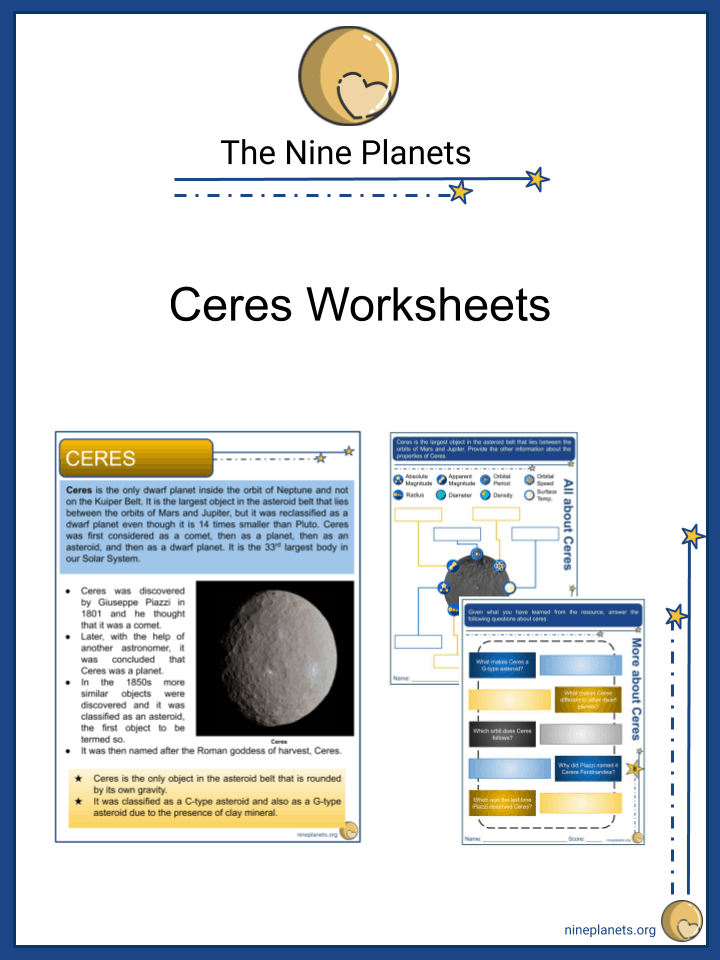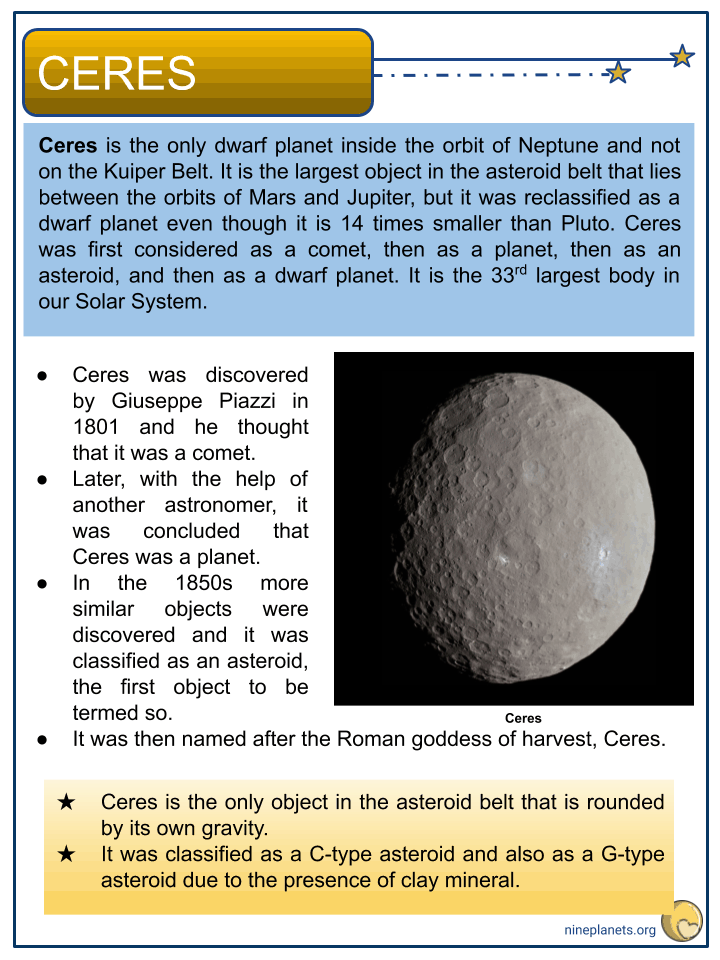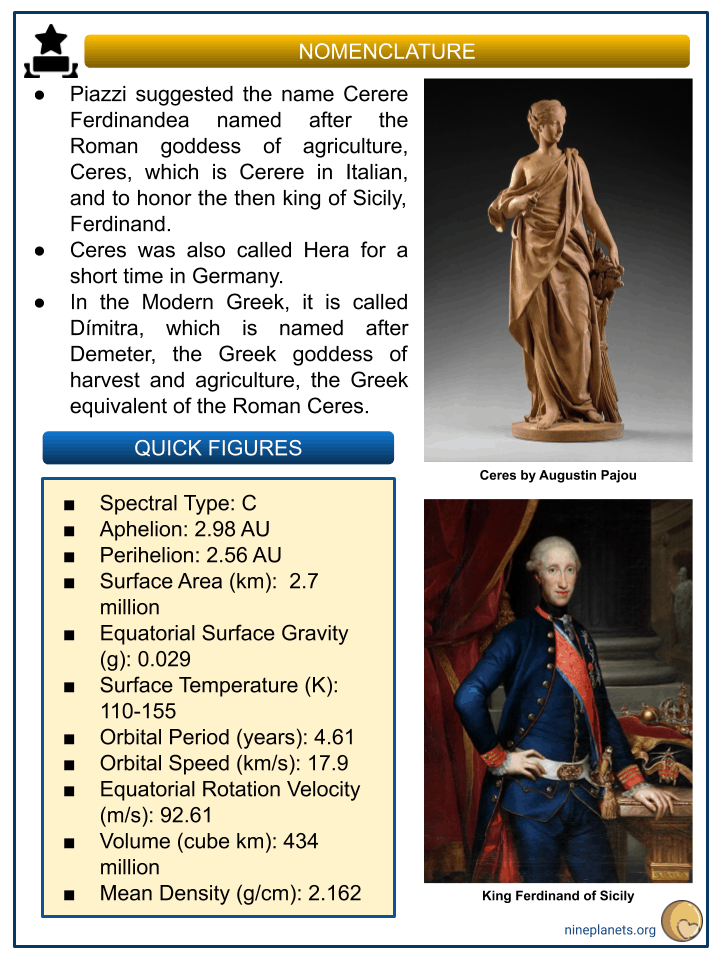Download Ceres Worksheets
Click the button below to get instant access to these premium worksheets for use in the classroom or at a home.

This worksheet can be edited by Premium members using the free Google Slides online software. Click the Edit button above to get started.
Download free sample
Not ready to purchase a subscription yet? Click here to download a FREE sample of this worksheet pack.
Resource Examples
Click any of the example images below to view a larger version.




Key Facts & Information
- Ceres is the only dwarf planet inside the orbit of Neptune and not on the Kuiper Belt. It is the largest object in the asteroid belt that lies between the orbits of Mars and Jupiter, but it was reclassified as a dwarf planet even though it is 14 times smaller than Pluto. Ceres was first considered as a comet, then as a planet, then as an asteroid, and then as a dwarf planet. It is the 33rd largest body in our Solar System.
- Ceres was discovered by Giuseppe Piazzi in 1801 and he thought that it was a comet.
- Later, with the help of another astronomer, it was concluded that Ceres was a planet.
- In the 1850s more similar objects were discovered and it was classified as an asteroid, the first object to be termed so.
- It was then named after the Roman goddess of harvest, Ceres.
- Ceres is the only object in the asteroid belt that is rounded by its own gravity.
- It was classified as a C-type asteroid and also as a G-type asteroid due to the presence of clay mineral.
Discovery
- In 1772, German astronomer Johann Elert Bode first suggested that an undiscovered planet could exist between the orbits of Mars and Jupiter.
- In 1776, the Titius-Bode law was proposed, which states that the bodies of some orbital systems orbit at semi- major axes in a function of planetary sequence in which each planet would be approximately twice as far from the Sun than before.
- In 1800, a group headed by Hungarian astronomer Franz Xaver von Zach sent requests to 24 experienced astronomers to combine their efforts and begin a methodical search for the suspected planet but they found several large asteroids instead.
- In January 1, 1801, Italian astronomer Giuseppe Piazzi discovered Ceres before receiving an invitation to join the group of von Zach.
- Piazzi was searching for the 87th star of the Catalogue of the Zodiacal stars of Mr la Caille, but found a star-like moving object which he thought as a comet.
- January 24 of the same year, Piazza announced his discovery to his two fellow astronomers, Barnaba Oriani and Johann Bode.
- In the September 1801 issue of the Monatliche Correspondenz, the information was published after Piazzi sent his complete observations to Oriani, Bode, and Jérôme Lalande in April of the same year in Paris.
- In December 31, 1801, von Zach and Heinrich Olbers finally found Ceres near the predicted position, after being lost in its predicted path, with the help of an efficient method of orbit determination by German mathematician Carl Friedrich Gauss.
Nomenclature
- Piazzi suggested the name Cerere Ferdinandea named after the Roman goddess of agriculture, Ceres, which is Cerere in Italian, and to honor the then king of Sicily, Ferdinand.
- Ceres was also called Hera for a short time in Germany.
- In the Modern Greek, it is called Dímitra, which is named after Demeter, the Greek goddess of harvest and agriculture, the Greek equivalent of the Roman Ceres.
Quick Figures
- Spectral Type: C
- Aphelion: 2.98 AU
- Perihelion: 2.56 AU
- Surface Area (km): 2.7 million
- Equatorial Surface Gravity (g): 0.029
- Surface Temperature (K): 110-155
- Orbital Period (years): 4.61
- Orbital Speed (km/s): 17.9
- Equatorial Rotation Velocity (m/s): 92.61
- Volume (cube km): 434 million
- Mean Density (g/cm): 2.162
Properties
- Ceres encompasses one-third of all of the mass found in the asteroid belt.
- From our point of view, the apparent magnitude of Ceres ranges from 6.7 to 9.3.
- Even at its brightest, it is still too dim to be seen by the naked eye.
- Its absolute magnitude is 3.34.
- Ceres has a radius of around 476 km, thus, one-third of the radius of the Earth.
- The diameter of Ceres is estimated to be about 945 km, which means that its comparative size is the length from the top to the bottom of the United Kingdom.
- Its surface is a mixture of water ice and different hydrated minerals, such as carbonates and clay.
- Ceres follows the orbit between Mars and Jupiter, within the asteroid belt.
- It takes about 4.6. Earth years for Ceres to make one trip around the Sun.
- As Ceres orbits the Sun, it completes a rotation every 9 hours making its day length one of the shortest in the Solar System.
- Ceres appears to be partially differentiated into a muddy mantle or core, and a less dense, but stronger crust which is about 30% ice.
- The dwarf planet probably no longer has an internal ocean of liquid water, but there is a presence of brine, and a high concentration of salt in the water that can flow through the outer mantle and reach the surface.
Formation
- Ceres is believed to have formed around 4.5 billion years ago when the Solar System was just forming.
- The swirling gas and dust were pulled by gravity, which resulted in the creation of the dwarf planet.
- Scientists described Ceres as an embryonic or protoplanet in which it started to form as a planet but failed to finish.
- Neptune’s strong gravity prevented Ceres from becoming a fully formed planet.
- Ceres settled into its current location among the rest of the leftover pieces of planetary formation.
- The composition of Ceres and its formation in the asteroid belt do not match. It seems that Ceres might also have formed as a centaur, an object with either a perihelion or a semi-major axis between those of the outer planets, between the orbits of Jupiter and Saturn, but was scattered into the asteroid belt as Jupiter migrated outward.
- It is also theorized that Ceres originally formed within the Kuiper Belt and migrated closer to the Sun due to the large gravitational influences.
- The ammonia salts detected in the Occator crater of Ceres supports the said theory.
Geology
- Ceres is covered in lots of small, young craters, no longer than 280 km.
- Its average surface temperature is about 235 K, which is relatively warm for an asteroid.
- The surface of Ceres is approximately the same as the land area of India or Argentina.
- In January 2014, water
- vapor was detected in its several regions, and thus it was discovered that water vapor comprises a lot of the external makeup of Ceres.
- It was determined that this might be the result of outgassing, or from a unique type of volcano, a cryovolcano.
- Outgassing is a common feature of a comet.
- The mantle of Ceres which is about 100 km thick could contain up to 200 million cubic km of water.
- Ceres is believed to be approximately 40-50% water by volume and 73% rock in weight.
- The thickness and density of the crust is not yet well determined.
- There are competing 2-layer or 3-layer model of its interior, excluding a possible small metallic core.
- TWO-LAYER MODEL
- Ceres has a core of chondrules and a mantle of mixed ice and micron-sized solid particulates.
- The sublimation of ice at its surface would leave a deposit of hydrated particulates of probably 20 m thick.
- With a large core, the boundary between the core and mantle should be warm enough for the pockets of brine.
- With a small core, the mantle should remain liquid below 110 km and a 2% freezing of the liquid reservoir would compress the liquid enough to force some to the surface, producing cryovolcanoes.
- A range of densities for the crust and mantle can be calculated from the types of meteorites that have impacted Ceres.
- With the CI-class meteorites, the crust would be approximately 70 km thick and have a density of 1.68 g/cc.
- With the CM-class meteorites, the crust would be approximately 190 km thick and have a density of 1.9 g/cc.
- THREE-LAYER MODEL
- Ceres has an inner muddy mantle of hydrated rock, such as clays, an intermediate layer of brine and rock with a depth of at least 100 km, and an outer 40-km thick crust of ice, salts, and hydrated minerals.
- It is unknown if Ceres has a rocky or metallic core, but the low central density suggests that it may retain about 10% porosity.
- The high density of its mantle relative to water ice reflects that it is enriched in silicates and salts.
Life Habitability
- The prospects for life on Ceres are positive and has gathered our attention for further observations.
- In 2017, organic molecules were discovered, the carbon-containing building blocks of life.
- These organics appear to be native and form on Ceres rather than arriving through asteroid or comet strikes.
- The two very distinct spots on the cratered surface of Ceres leads to the speculation of a possible cryovolcano that erupts volatiles such as water, ammonia, or methane.
- Ahuna Mons is the largest mountain or the suggested massive cryovolcano on the surface of Ceres.
- In late 2016, Dawn, the space probe found definite evidence of water molecules on the surface of Ceres.
- These factors coupled with the 20% carbon mass of Ceres could provide the right conditions for organic chemistry.
Did You Know?
- Giuseppe Piazzi observed Ceres for a total of 24 times. He last observed it in February 11, 1801, before he got sick.
- The closest approach of Ceres to the Earth is speculated to happen in 2032, at a distance of approximately 1.6 AU.
- The word cereal comes from the name Ceres.
- The rare-earth element Cerium was named after Ceres, but it was later renamed as palladium after the asteroid Pallas.
- Ceres holds the title of the smallest dwarf planet in our Solar system.
- However, recent discoveries suggest that there may be a new, smaller dwarf planet named Hygiea.